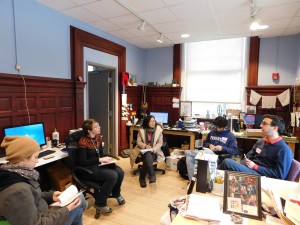One of the first challenges the team ran into as we began the first phase of this project was how to define “innovation.” It’s a pretty standard buzzword, with all the problems that that entails: namely, everyone wants it, but nobody knows exactly what it is. Moving targets are impossible to work with on long projects, so we set about trying to nail this one down.
Oftentimes, epiphanies come after moments of intense confusion, and for us that confusion happened when we looked at this video [cippgh.org/documentary] from the Children’s Innovation Project, the coordinators of which are graciously serving as consultants on this project. If you watch the video, you’ll hear innovation mentioned and discussed several times over the course of the video, but the big moment occurred 19 minutes in, with a few comments from Jeremy Boyle:
“Innovation is finding something new in something known,” and “We approach technology as a raw material, not simply as a tool.”
Here was the clearest distillation of their mindset we encountered, and with it we had something approximating a mission. The essential problem on our end as designers was that our sector tends to think of innovation in terms of technology—our tech team optimized an algorithm and got another 10,000 polygons in, Google made VR for your cellphone, etc.—rather than in terms of technique, or what can be done in a medium already established.
of their mindset we encountered, and with it we had something approximating a mission. The essential problem on our end as designers was that our sector tends to think of innovation in terms of technology—our tech team optimized an algorithm and got another 10,000 polygons in, Google made VR for your cellphone, etc.—rather than in terms of technique, or what can be done in a medium already established.
We don’t spend enough time thinking about all the weird properties of wood.
That’s not to say the world doesn’t recognize or appreciate innovations of technique: big names like Spielberg and Abrams got that way because of technique innovations within an established medium. And artists often talk in such terms among themselves. However, in the wider scheme, when we assemble all the technologists and artists and designers and business people in a room and command them, “Innovate!” the process that results favors a new doodad over discovered a weird emergent property of a previous one.
Talking with our client representative Rebecca led to an interesting discussion of what they thought worked and failed in previous semesters, and it looks like these principles of innovation are really what they are chasing after. So for the purposes of this project, the team at Aristeia is defining innovation just like that: we’re after new techniques for discovering and bonding over existing (in some cases downright old) materials.
What does this do to the project? Mostly it tells us not to spend too much time fantasizing about the bleeding-edge of computing when we are compiling our design goals. The museum needs a plan that will work equally well with its large collection of plastic wheels as well as its 3D printer.
- Written by Antonin Fusco
